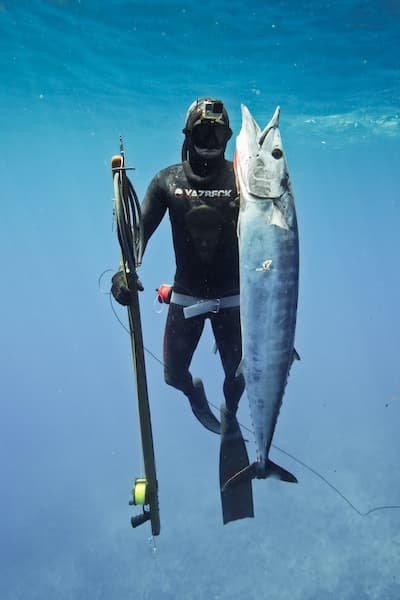
 Roni Essex
Freediver, Spearo, Creator
Roni Essex
Freediver, Spearo, Creator

 Roni Essex
Freediver, Spearo, Creator
Roni Essex
Freediver, Spearo, Creator
Spearfishing, especially when targeting large pelagic fish such as tuna, marlin, or wahoo, demands precision, strength, and durability. A vital component of any successful spearfishing adventure is the speargun itself. As spearos venture into deeper waters to chase larger, faster fish, the choice of speargun becomes a critical factor in determining success. While aluminum spearguns have long been considered a standard option, more and more seasoned spearfishers are gravitating towards wooden spearguns, particularly for their strength and performance in handling big pelagics. In this article, we'll explore why wooden spearguns have distinct advantages over their aluminum counterparts when it comes to big spearguns designed for pelagic hunting.
One of the most critical factors in spearfishing is how well a speargun handles underwater. Wooden spearguns, by nature of the material, offer superior buoyancy control. Wood has a natural ability to float, which means that larger wooden spearguns are generally more neutrally buoyant when equipped with shafts, even after firing. This neutral buoyancy helps prevent the speargun from sinking too quickly or rising too much after a shot, allowing spearfishers to maintain better control of their gear.
In contrast, aluminum spearguns, being denser than wood, tend to be heavier and less buoyant. As a result, they often sink more readily, especially when equipped with heavier spears or extra bands. In open water, this can make it more challenging to handle, leading to fatigue for the spearfisher, especially on long dives where endurance is key. For large pelagic fish, which require precision and sustained effort, this added weight can make a significant difference.
When you're targeting large, fast-moving pelagics, accuracy is everything. A misfired or errant shot not only wastes precious time but can also scare away potential catches. One of the defining advantages of wooden spearguns is their ability to minimize recoil. Wood, being a denser and more absorbent material than aluminum, has the capacity to absorb much of the force generated during a shot. This results in less recoil, which ultimately helps maintain accuracy and keeps the shooter on target even when firing powerful, multi-band setups.
Aluminum spearguns, in contrast, tend to transmit more of the recoil force back to the shooter. While modern designs and materials have made strides in reducing recoil, aluminum still cannot match the dampening effect that wood naturally provides. With big pelagic species requiring long-range and accurate shots, the reduced recoil of wooden spearguns becomes a clear advantage.

Spearfishing for large pelagic fish requires a speargun that can handle immense pressure. Wooden spearguns, particularly those made from durable hardwoods like teak or mahogany, excel in this regard. These types of wood are not only strong but also naturally resistant to water, salt, and environmental degradation. Many high-end wooden spearguns are constructed from laminated wood, which further increases strength and prevents warping over time. This is critical when hunting large pelagics, where the speargun will be exposed to extreme underwater environments and must withstand the stress of pulling in massive fish.
Aluminum, while also strong, is more prone to corrosion, especially in saltwater environments. Though most aluminum spearguns are anodized or treated to resist corrosion, they can still wear down over time, particularly at weak points like joints or threaded connections. Furthermore, aluminum can bend or dent if subjected to heavy impacts or prolonged strain, whereas wooden spearguns tend to remain sturdy even after years of use.
Wooden spearguns offer unmatched levels of customization compared to aluminum models. Since wood can be easily shaped and crafted, many spearfishers opt for custom-built wooden spearguns tailored to their specific needs. This includes adding extra bands for power, lengthening the barrel for improved range, or shaping the handle for a more ergonomic grip. Wooden spearguns are often equipped with tracks that can guide the spear more accurately, allowing spearfishers to fine-tune their equipment for better precision.
While aluminum spearguns are available in a wide variety of models, they typically lack the same degree of customization options. Aluminum’s rigid structure limits how much it can be adjusted or altered without compromising its integrity. For spearos looking to modify their gear to suit their unique hunting styles, wooden spearguns are the better choice.

Beyond the functional benefits, many spearfishers appreciate the aesthetics and craftsmanship of wooden spearguns. They often have a traditional, handcrafted feel that connects the modern spearfisher to the roots of the sport. Many wooden spearguns are made by skilled artisans, and their natural beauty and tactile warmth can make them feel like an extension of the spearfisher rather than just a tool.
Aluminum spearguns, while efficient and modern in design, lack this connection to tradition. Their utilitarian appearance and cold feel don’t offer the same emotional connection to the sport that wooden spearguns do.
Big pelagic spearfishing often involves tracking swift, elusive fish through open water. This means spearguns must be highly maneuverable. One of the advantages of wooden spearguns is their superior weight distribution. The density of the wood allows for a more balanced speargun, making it easier to pivot and aim quickly.
Aluminum spearguns tend to be heavier at the barrel, which can make them harder to swing into position when tracking fast-moving fish. This uneven weight distribution can cause delays in aiming, which is crucial when every second counts in a spearfishing scenario. A well-balanced wooden speargun offers more fluid movement, enabling spearos to track and target fast pelagics more effectively.

The marine environment is unforgiving, especially when spearfishing for large pelagics in open ocean settings. Wooden spearguns, especially those treated with oils and resins, are incredibly resilient to harsh saltwater conditions. Teak, one of the most commonly used woods in speargun construction, is naturally oily and resistant to rot, making it ideal for prolonged exposure to seawater. With proper maintenance, a high-quality wooden speargun can last for decades.
Aluminum spearguns, though treated to resist corrosion, are more susceptible to the long-term effects of exposure to saltwater. Over time, even minor abrasions in the coating can lead to corrosion, which can weaken the integrity of the gun. In harsh conditions, where reliability is paramount, wooden spearguns offer a longer-lasting solution.
When spearfishing for large pelagic fish, stealth is a key factor. The natural composition of wood makes wooden spearguns quieter when submerged. They produce less noise both when being maneuvered underwater and during the shot itself. This quietness is crucial, as pelagic fish are highly sensitive to disturbances in their environment. Even a slight noise from the speargun can spook a potential target, causing it to dart away before a shot can be taken.
Aluminum spearguns, by comparison, can produce more noise underwater due to the metal construction. The sounds of moving parts or even handling the speargun can alert fish to your presence. This subtle difference can make or break a successful hunt in pelagic spearfishing.

While aluminum spearguns have their merits, particularly for smaller fish or shorter-range applications, wooden spearguns stand out as the superior choice for targeting large pelagic species. The combination of buoyancy control, recoil dampening, durability, and customization options make wooden spearguns a versatile and reliable option for serious spearfishers. Add to that their aesthetic appeal, resilience in harsh conditions, and stealthy silence underwater, and it's easy to see why many experts prefer wooden spearguns for big pelagic fish.
For those looking to maximize their performance and enjoyment in the water, investing in a high-quality wooden speargun is an excellent choice—one that will likely last a lifetime and bring many successful hunts in the deep blue.